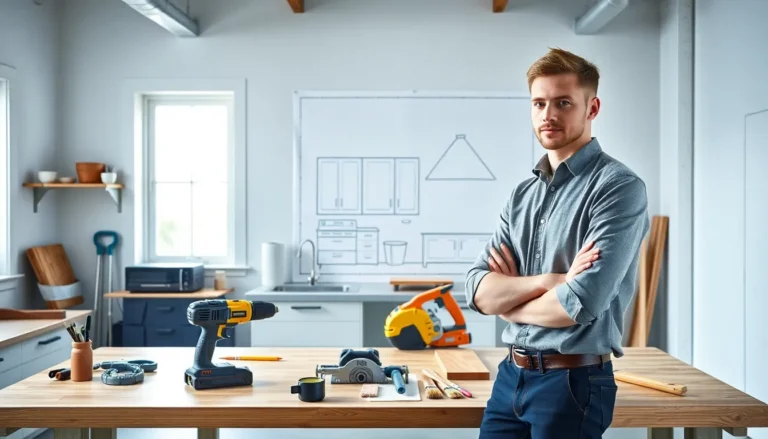Table of Contents
ToggleEver walked into a home so smart that even the lights seem to smile at you? Welcome to the wondrous world of home automation. These magical systems aren’t just about controlling your lights or running your coffee maker with a single command: they’re about transforming your living space into a futuristic haven. If you’re intrigued by the idea of having your home do all the heavy lifting, like keeping your pet entertained or ensuring your plants are watered, then this guide on home automation installers is just what you need.
Understanding Home Automation

Home automation is a growing trend across the globe. It involves connecting various devices and systems within a home to a central hub, allowing residents to control everything from lights to security systems through their smartphones or voice assistants. Imagine a house that knows when you’re home, adjusts the thermostat to your liking, and even locks the doors behind you. The essence of home automation lies in its ability to enhance convenience, efficiency, and security, making everyday living smoother than ever.
The heart of a successful home automation system relies on the Internet of Things (IoT). Essentially, IoT includes all the devices that are connected to the internet and can communicate with one another. From smart bulbs to connected security cameras, these devices work harmoniously to give homeowners not just comfort but control over their home environment.
Benefits of Home Automation
Why should homeowners consider investing in home automation? The benefits are plenty. First and foremost is convenience. Homeowners can control their devices from anywhere in the world with an internet connection. Forgot to turn off the lights while on vacation? No problem. A quick tap on the smartphone app, and it’s done.
Energy efficiency stands out as another noteworthy benefit. Smart thermostats, like the Nest, learn user behaviors and optimize heating and cooling, which can significantly reduce energy bills. Also, automated lighting systems can help minimize electricity consumption by adjusting according to natural light.
Security is another primary concern that automation addresses. Home automation systems can include security cameras, smart locks, and alarms, allowing homeowners to monitor their premises in real time, wherever they are. With alerts sent directly to their phones, residents can feel secure and aware, even on the go.
Choosing the Right Home Automation Installer
Selecting the right home automation installer can make a world of difference in the overall experience and effectiveness of your automated home system. Here are some key factors to consider:
Factors to Consider When Hiring Installers
- Experience: Look for installers who have a solid track record with home automation projects. Check for certifications and previous client reviews to gather insights into their reliability and expertise.
- Variety of Systems: A good installer should be knowledgeable about various home automation products and systems. They should be equipped to recommend the best options based on your specific needs.
- Support and Service: Post-installation support is crucial. Ensure the installer offers customer service for troubleshooting and maintenance.
- Pricing Transparency: Always discuss the pricing structure upfront. Installations should match your budget without hidden fees.
Key Questions to Ask Potential Installers
When interviewing potential installers, asking the right questions can help ensure you choose the best fit for your home:
- What brands and systems do you specialize in?
- Can you provide references from past clients?
- What kind of warranty or guarantee do you offer?
- How do you handle updates or repairs after installation?
Understanding the Installation Process
The installation process for home automation can vary based on the complexity of the system being set up. Generally, it commences with an assessment of the property. The installer will review existing electrical wiring, internet connectivity, and Wi-Fi coverage to plan the ideal setup.
Once everything is in place, the actual installation begins. Expect to see components being installed, including wiring for lights, networking equipment, and possibly even new devices like smart thermostats or cameras. Following the installation, a thorough testing phase ensures all components are functioning as anticipated. Finally, the installer should walk you through the system, showing how to use the devices and apps, ensuring you feel comfortable navigating your new smart home.
Common Home Automation Systems and Technologies
The world of home automation boasts a range of systems and technologies:
- Smart Lighting: Systems like Philips Hue allow users to control brightness and color with ease.
- Thermostats: Devices such as the Ecobee not only learn user preferences but can also be programmed for energy efficiency.
- Security Systems: Companies like Ring provide comprehensive solutions that unify cameras, alarms, and lighting under a single control interface.
- Central Hubs: Products like Amazon Echo or Google Nest work as the brain of your home, enabling control of various devices seamlessly.
Future Trends in Home Automation
The future of home automation appears bright and innovative. Artificial Intelligence (AI) is set to revolutionize how smart homes operate. AI algorithms can learn user habits and automate everyday tasks more efficiently, tailoring home environments to individual needs.
Voice control is also anticipated to grow, with voice-activated devices becoming more intuitive and responsive. Besides, the rise of 5G technology promises to enhance connectivity, enabling even faster communication between devices. Interoperability among different brands and systems is another area to keep an eye on: the goal is for all devices, regardless of the manufacturer, to work together seamlessly.







